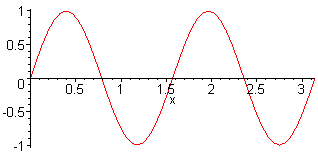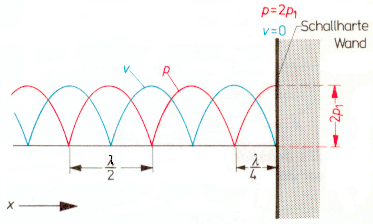

| Deutsche Version |
| A standing wave is the vibration state of a stable system. An example of this is the vibrating string of a musical instrument, or the column of air in an organ pipe. These waves have a “wave-like” look, but nothing is moving. The string is clamped between two fixed ends with length L; which is called a node also known as a zero crossing. The location directly between two nodes is called an antinode. Shown below are the natural vibrations of an idealized string, which is assumed to be perfectly flexible. The stiffness is assumed to be zero. The frequencies of the vibrations form harmonics, also called partials. c = speed of sound. L = length of the string. The fundamental wave is known as the first harmonic. |
 1st harm. L = λ/2 = π f1 = c / (2·L) |
 2nd harm. L = λ f2 = 2·f1 = c / L |
 3rd harm. L = 3 λ / 2 f3 = 3·f1 = 3·c / (2·L) |
 4th harm. L = 2 λ f4 = 4·f1 = 4·c / (2·L) |
| Note: Note: The distance between two nodes (knots) or two maxima (antinodes) is λ/2. The distance between a node (maximum) and an antinode (minimum) is λ/4. |
|
2 - Standing waves (acoustic resonance) on pipes (flutes)
 |
Druck = pressure and Frequenz = frequency 1st harm. L = λ / 2 = π f1 = c / (2 · L) 2nd harm. L = λ f2 = 2 · f1 = c / L 3rd harm. L = 3 λ / 2 f3 = 3 · f1 = 3 c / (2 · L) Open tube |
| Oscillations of a column of air of an open tube (flute). At the open end theoretically there must be a sound pressure node, if one leaves aside the end correction. |
 |
Druck = pressure and Frequenz = frequency 1st harm. L = λ / 4 = π · 1 / 4 f1 = c / (4 · L) 3rd harm. L = 3 λ / 4 f3 = 3 · f1 = 3 c / (4 · L) 5th harm. L = 5 λ / 4 f5 = 5 · f1 = 5 c / (4 · L) Left single-edge closed tube |
| Oscillations of an air column of a single-edge closed tube (flute); also stopped pipe (gedackt). At the closed end theoretically there must be an antinode of the sound pressure. |
| There are misunderstandigs of waves in air, because sinusoidal patterns can indicate the nodes and antinodes of the displacement of the sound, the particle velocity of the sound, and the sound pressure or the sound density. Sound engineers using microphones are only interested in the behavior of the sound pressure deviations. Notice: A pressure node corresponds to a displacement antinode! |
3 - Room modes (standing waves) between sonically hard parallel walls
Where do I set up my speakers? Where is the best listening spot? Where to go with the acoustic treatment?
The following fundamentals for the acoustics of low frequency sound waves in rooms you should know.
This applies to the recording room as well as for the playback room.
| The room resonances formed between the boundary surfaces of a room, are called "standing waves" or room modes, or modes. They arise if a multiple of half the wavelength (λ/2) fits between the boundary surfaces of an area. Therefore, one need not necessarily parallel walls. Sound technicians are interested in the behavior of the sound pressure, because by its effect our eardrums and the microphone diaphragms are moved, see: Effect and cause. |
 |
A standing wave as sound pressure distribution:
3rd harmonic (2nd overtone) − 3 nodes and 4 antinodes
Room modes as sound pressure distribution
Calculation of the three modes (eigenmodes) - resonances of rectangular rooms
An eigenmode (eigentone) is the European name for a standing wave.
| Note: In practice only low frequencies as sound pressure below 300 Hz are considered as room modes. Higher modal frequencies become less important, because their disturbing effect is masked by other acoustic effects. On the walls there are formed by the modes always sound pressure maxima - that are sound pressure antinodes (or particle velocity minima = nodes). |
| By the following formula standing waves that are room resonances (modes), which are built between the reverberant boundary surfaces of a rectangular room, can be determined in their frequency. On a sound-reflecting wall (boundary) the absorption coefficient is α = 0.  Where: f = frequency of the mode in Hz c = speed of sound 343 m/s at 20 °C nx = numbers of natural oscillations (room length) (1, 2, 3, ...) ny = numbers of natural oscillations (room width) (1, 2, 3, ...) nz = numbers of natural oscillations (room height) (1, 2, 3, ...) L, B, H = length, width and height of the room in meters A standing wave 1st order of the fundamental frequency = f1 occurs, when half the wavelength of the excitation frequency fits between the sonically hard boundary surfaces. For the axial mode we get the lowest frequency : f1 = c / (2 · L) Where:c = speed of sound343 m/s at 20 °C f1 = frequency in Hz of the axial mode L = longest distance in meters of the boundary surfaces. The standing waves of higher order are calculated from the integer multiples of the 1st order mode. f3 = 3 · f1 f4 = 4 · f1 |
 |
Antinodes pressure maximum |
Nodes zero crossing |
Wavelength | Frequency | Harmonics | Overtones |
| 2 | 1 | λ = 2 × L | f1 = 1 × c / (2 × L) | 1st harmonic | fundamental | |
| 3 | 2 | λ = L | f1 = 2 × c /(2 × L) | 2nd harmonic | 1st overtone | |
| 4 | 3 | λ = (2 × L) / 3 | f1 = 3 × c / (2 × L) | 3rd harmonic | 2nd overtone | |
| k + 1 | k | λ = (2 × L) / k | f1 = k × c / (2 × L) | k harmonic | (k − 1) overtone |
| k = 1, 2, 3, ... |
| The sound pressure is actually a longitudinal wave a), in contrast to this more presentable transverse wave b). |
| Direction of oscillation Direction of propagation |
 |
| Standing wave modes as sound pressure distribution between the walls. Wave with two open ends. |
 1st harm. L = λ/2 = π f1 = c / (2·L) |
 2nd harm. L = λ f2 = 2·f1 = c / L |
 3rd harm. L = 3 λ / 2 f3 = 3·f1 = 3·c / (2·L) |
 4th harm. L = 2 λ f4 = 4·f1 = 4·c / (2·L) |
Here, the sound pressure of a sine wave with harmonics is presented |
| This is not the representation of sound pressure vibrations between walls in a small room. These are vibrations of a string (displacement amplitudes). |
 |
A typical wrong figure with nodes at the walls. Showing the air displace- ment was not desired. |
| A string is clamped between two "fixed ends". At the ends will be a wave node. A wave between two hard walls is considered as a sound pressure with "loose ends". Therefore on the sides of the wall there appears as sound pressure a wave maximum or an antinode. |
Not good: Standing Wave - Wikipedia and Resonant room modes - Wikipedia
This is correct : From Wikibooks, the open-content textbooks collection
 |
Sonically hard wall |
Spatial distribution of sound pressure p (red) and particle velocity v (blue) in a |
| Here is a nice animation of a standing wave - Explanation by superposition with the reflected wave. This setting must be: "Reflection from a free end". http://www.walter-fendt.de/ph14e/stwaverefl.htm |
|
| The frequency at which the first (lowest) room mode occurs, is calculated using the following formula: Frequency = speed of sound c / (longest room dimension × 2) |
| Comparison of the reflections in an echo chamber and an extremely highly damped room. |
 |
| Sound pressure reflections (modes) at sonically hard walls, like in an echo chamber (wet). |
 |
| Sound pressure reflections (modes) at sonically soft walls, like in a reflection free room (dry). |
 |
Sonically soft wall |
| Spatial distribution of sound pressure p (red) and particle velocity v (blue) in a schematized standing wave with total reflection from a sonically soft wall. At a distance of λ / 4 from the wall the sound pressure is p = maximum. |
 |
| A typical room (control room) with axial modes and sound pressure anti nodes at the walls |
| Room Eigenmodes Calculator − Jörg Hunecke This calculator determines the room eigenmodes with the 20 lowest eigenfrequencies for rectangular rooms and presents them in ascending order. |
The Pressure Chamber Effect
| Even below the lowest room mode low frequencies are reproducible. One uses the pressure chamber effect in a with hard boundary surfaces equipped small room, where the room must be sealed pressure-tight. The "dB Drag Racing" fans need that for their car loudness competitions. |
 |
| RPG Triffusor |
| Absorption - Reflection - Diffusion - Combination |
 |
| Notice: At a hard reflecting wall (closed end) there is a sound pressure antinode but at the same time there is a particle displacement node. When one speaks of standing waves, it must be expressed clearly that we mean amplitudes of the acoustic pressure changes that move our eardrums. That is mostly forgotten. The sound pressure derivtions of air are oscillating with antinodes and nodes - at the same time the displacement of air particles are oscillating with nodes and antinodes. The relationship between the maximum pressure change Δ pm and the maximum displacement amplitude of the air particles ξm is: Δ pm = (v ρ ω) ξm. |
| Distinguish the amplitudes of particle displacement, sound
pressure, sound velocity, and pressure gradient. Sound pressure antinode is particle displacement node of the air particles. Particle displacement antinode of the air particles is sound pressure node. |
 |
| At rest, a green air particle has the same position as in the oscillation condition. The displacement of air particles is going through a zero crossing while the sound pressure amplitude with p maximum (condensation, compression) or a minimum (rarefaction, expension) shows. At rest, a red air particle is at the maximum or minimum of the amplitude of the same time there is a zero crossing of the sound pressure wave. Thus, there the sound pressure is zero; ie the normal static air pressure is present alone. |
 |
|
In graphic representations of standing waves (room modes) between two walls, usually there is not specified whether there is shown the sound pressure as the pressure variation in the air, or the displacement of the air. However, this clarification is really necessary. The figures above show the important difference. Left = sound pressure (antinodes) and right = displacement (nodes). Notice: The effect of standing waves reports our hearing, but the sound pressure deviations (fluctuations, variations) move effectively our eardrums. |
| back |
Search Engine |
home |